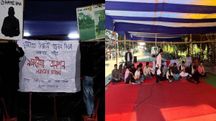The Kaliabor Tragedy: A Societal Failure
Three children, aged 8 and 11, allegedly killing a 6-year-old minor girl at Kaliabor in Nagaon district of Assam has rattled the collective conscience of the state.
 The Kaliabor Tragedy: A Societal Failure
The Kaliabor Tragedy: A Societal FailureSampurnaa Bharadwaj
Three children, aged 8 and 11, allegedly killing a 6-year-old minor girl at Kaliabor in Nagaon district of Assam has rattled the collective conscience of the state. The idea of the children being ‘porn addicts capable of conspiracy and execution of a dastardly crime’ is unfathomable to us distraught child rights practitioners. While an investigation of this highly sensitive case is underway, the social context culminating into this heart wrenching tragedy needs to be examined.
The past one and a half years of the COVID-19 pandemic has resulted in schools and educational institutions being closed. With learning transitioning to the online mode, a smartphone is a necessity for every school going child. A smart device with internet connection is a window to the world. Parents have little or no control over the content a child accesses on their smartphone. Pornography, cyber bullying, identity theft, and financial frauds by supposed friends on the internet are all pitfalls of unrestricted internet access.
Children at an impressionable age are curious and willing to experiment. During pre-adolescence and adolescence, they undergo massive physical and hormonal changes. Accessing pornographic content available on a parent’s mobile phone is exciting to them, bordering on adventurous. The child believes viewing porn as the right thing to do, since it is available on the parent’s phone, who must be watching it too. Forbidding the child to access the adult content is presumed to be a challenge by them. After all, haven’t us humans always been fascinated by the forbidden? Thus, begins the process of stealthily accessing adult content, digging deeper every day to find better and more exciting content. Little does one know that internet algorithms are designed to access, store, and predict our browsing behaviors. The internet is a genie that displays a million things similar to what we may have clicked on. Bags, you say? Here, 20 different bags at 80 per cent off! All of our preferences, purchases, casual browsing, even the time spent on a particular post is stored and analyzed to present analogous content. A child watching pornographic content on a smartphone has access to the entire gamut of such content available on the internet with the click of a button. The same goes for violence. Movies and video games have normalized violence and made it entertaining. Unhindered access to violence and adult content for children below the age of 18, with no parental restrictions exercised. When three minor children act out what they regularly view on television and internet, we call their state of mind culpable.
The harrowing incident of the 6-year-old girl losing her life allegedly due to an act committed by three other children indicates a massive societal failure. We, as a society, have failed to ensure the developmental rights of the children – their right to be educated, to have access to play and leisure, to have freedom of thought and conscience. We have failed to provide a safe and healthy environment to nurture their psychological development.
For the children who have been alleged to be involved in this traumatic incident, we have failed to protect them as well. Children below the age of 18 years who are alleged to be in conflict with law come under the purview of the Juvenile Justice (Care and Protection of Children) Act, 2015 (JJ Act). Section 2 (13) of the JJ Act defines a “child in conflict with law” as “a child who is alleged or found to have committed an offence and who has not completed eighteen years of age on the date of commission of such offence”. The Act intends to cater to the basic needs of children in conflict with law and children in need of care and protection (CNCP) through proper care, protection, development, treatment, social reintegration, by adopting a child-friendly approach in the adjudication and disposal of matters in the best interest of children and for their rehabilitation. The police, administration, and media need to be sensitive about using the correct semantics while addressing the children in conflict with law and avoid using adversarial or accusatory words as guided by the Principle of Non-Stigmatizing Semantics enshrined in the General Principles of Care and Protection of Children in chapter II of the JJ Act. Sensationalism through repeated dramatic broadcast of the news will result in a media trial of the three minor children, which needs to be avoided at all costs. The JJ Act establishes institutions and bodies such as the Child Welfare Committee and the Juvenile Justice Board which are authorized to adjudicate in matters pertaining to children in conflict with law. A child is innocent of any mala fide or criminal intent, which forms the basis of the Juvenile Justice system – a system that seeks reform rather than punishment. Therefore, to demonize the children and assume their ability to comprehend the nature and consequences of their act is unacceptable. It is common in such disconcerting situations to deny children in conflict with law the right to explain their side of the story. While our hearts go out to the deceased child and her family, the children alleged to have committed the offence in the Kaliabor incident have the right to be heard and participate in all processes and decisions affecting their interest, as stated in the JJ Act’s Principle of Participation. The children’s right to participation is also protected by the United Nations Convention on the Rights of the Child, 1989 (UNCRC), to which India is a signatory. For children below 18 years, who are found on the wrong side of law, the JJ Act intends to reform, rehabilitate, and reintegrate them into the society by allowing them a fresh start.
Every child is a product of the socio-economic context in which they are raised. Society plays a pivotal role in the way a child perceives the world. An incident like this cannot be viewed in isolation, devoid of the social milieu in which it has occurred. For a child to grow into a fully functioning adult, s/he needs to have accessed to all the rights – survival, development, protection, and participation.
Age appropriate education is instrumental to the child developing the mental faculties to make rational decisions. Schools not only educate children in their curriculum. Children learn social skills, life skills, build relationships, resolve conflicts, and thus build their social and emotional quotients along with their intellectual capabilities at school. Gradual reopening of schools by following appropriate COVID protocols is a welcome step to bring back children hiding behind their screens into the real world.
Children need care and protection from exploitation, abuse, harassment, and neglect. Parents, teachers, and caregivers have the biggest share of responsibility to ensure that the rights of children are protected. An unfortunate incident of a child losing her life should spur us into action to implement the rights of children in letter and spirit and prevent a reoccurrence of the same.
Copyright©2025 Living Media India Limited. For reprint rights: Syndications Today









